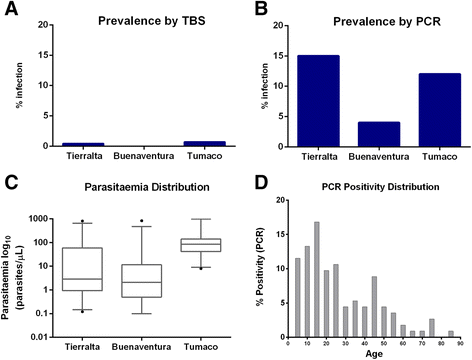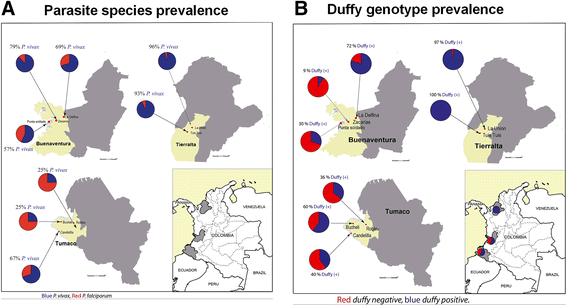High prevalence of sub-microscopic infections in Colombia
- PMID: 25971594
- PMCID: PMC4438632
- DOI: 10.1186/s12936-015-0711-6
High prevalence of sub-microscopic infections in Colombia
Abstract
Background: Malaria transmission in Latin America is typically characterized as hypo-endemic and unstable with ~170 million inhabitants at risk of malaria infection. Although Colombia has witnessed an important decrease in malaria transmission, the disease remains a public health problem with an estimated ~10 million people currently living in areas with malaria risk and ~61,000 cases reported in 2012. This study aimed to establish the malaria prevalence in three endemic regions of Colombia to aid in designing new interventions for malaria elimination.
Methods: A cross-sectional survey was conducted in three regions of Colombia with different malaria epidemiological profiles: Tierralta (Ta), Tumaco (Tu) and Buenaventura (Bv). The Annual Parasite Index (API) was 10.7, 6.9 and 3.1, respectively. Participants were asked to respond to a sociodemographic questionnaire and then were bled to determine the Duffy genotype and the prevalence of malaria infection by microscopy and quantitative real-time PCR (qPCR).
Results: The study was conducted between October 2011 and January 2012. Eight sentinel sites with 1,169 subjects from 267 households were included. The overall prevalence of sub-microscopic infections measured by thick blood smear (TBS) was 0.3% (n=4) whereas by qPCR it was 9.7% (n=113), with a greater proportion (13%) in 40-50 years old individuals. Furthermore, different regions displayed different prevalence of sub-microscopic infections: Bv 12%, Ta 15%, and Tu 4%. From these 113 samples (qPCR), 74% were positive for P. vivax and 22% for P. falciparum, and 4% were mixed infections, which correlates to the overall parasite prevalence in Colombia. This study showed that in the southern Pacific coast of Colombia (Bv and Tu), around 56% of the population have a Duffy-negative genotype, compared to the northern region (Ta) where the percentage of Duffy-negative genotype is around 3%.
Conclusions: Sub-microscopic infections are prevalent across different regions in Colombia, particularly in areas with relatively low transmission intensity. The poor microscopy results suggest the need for more sensitive diagnostic tools for detection of sub-microscopic infections. This study underscores the importance of conducting active case surveillance to more accurately determine malaria incidence, and highlights the need for updating the malaria guidelines to track and treat sub-microscopic malaria infections.
Figures


Similar articles
-
The detection of cryptic Plasmodium infection among villagers in Attapeu province, Lao PDR.PLoS Negl Trop Dis. 2017 Dec 20;11(12):e0006148. doi: 10.1371/journal.pntd.0006148. eCollection 2017 Dec. PLoS Negl Trop Dis. 2017. PMID: 29261647 Free PMC article.
-
History of malaria treatment as a predictor of subsequent subclinical parasitaemia: a cross-sectional survey and malaria case records from three villages in Pailin, western Cambodia.Malar J. 2016 Apr 26;15:240. doi: 10.1186/s12936-016-1284-8. Malar J. 2016. PMID: 27118311 Free PMC article.
-
Detection of Duffy blood group genotypes and submicroscopic Plasmodium infections using molecular diagnostic assays in febrile malaria patients.Malar J. 2024 Jun 20;23(1):194. doi: 10.1186/s12936-024-04875-5. Malar J. 2024. PMID: 38902674 Free PMC article.
-
Meta-analysis of the prevalence of malaria associated with pregnancy in Colombia 2000-2020.PLoS One. 2021 Jul 30;16(7):e0255028. doi: 10.1371/journal.pone.0255028. eCollection 2021. PLoS One. 2021. PMID: 34329329 Free PMC article.
-
Malaria in Brazil, Colombia, Peru and Venezuela: current challenges in malaria control and elimination.Malar J. 2017 Jul 4;16(1):273. doi: 10.1186/s12936-017-1925-6. Malar J. 2017. PMID: 28676055 Free PMC article. Review.
Cited by
-
Clinical Outcomes of Submicroscopic Infections and Correlates of Protection of VAR2CSA Antibodies in a Longitudinal Study of Pregnant Women in Colombia.Infect Immun. 2018 Mar 22;86(4):e00797-17. doi: 10.1128/IAI.00797-17. Print 2018 Apr. Infect Immun. 2018. PMID: 29378797 Free PMC article.
-
Is there malaria transmission in urban settings in Colombia?Malar J. 2015 Nov 14;14:453. doi: 10.1186/s12936-015-0956-0. Malar J. 2015. PMID: 26573620 Free PMC article.
-
Antibody Profiling in Naïve and Semi-immune Individuals Experimentally Challenged with Plasmodium vivax Sporozoites.PLoS Negl Trop Dis. 2016 Mar 25;10(3):e0004563. doi: 10.1371/journal.pntd.0004563. eCollection 2016 Mar. PLoS Negl Trop Dis. 2016. PMID: 27014875 Free PMC article.
-
Implementation and validation of a new qPCR assay to detect imported human Plasmodium species.Microbiol Spectr. 2025 Jan 7;13(1):e0162224. doi: 10.1128/spectrum.01622-24. Epub 2024 Dec 10. Microbiol Spectr. 2025. PMID: 39656014 Free PMC article.
-
Malaria epidemiology in low-endemicity areas of the northern coast of Ecuador: high prevalence of asymptomatic infections.Malar J. 2017 Jul 26;16(1):300. doi: 10.1186/s12936-017-1947-0. Malar J. 2017. PMID: 28747199 Free PMC article.
References
-
- WHO . World Malaria Report 2014. Geneva: World Health Organization; 2014.
Publication types
MeSH terms
Grants and funding
LinkOut - more resources
Full Text Sources
Other Literature Sources

